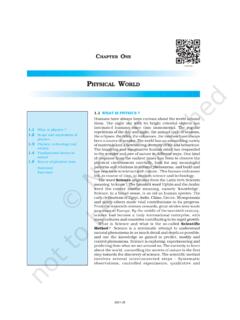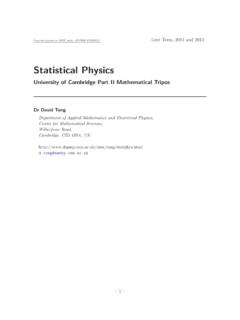Transcription of ContinuousSymmetriesandConservationLaws. …
1 Nature always creates the best of all (384 BC 322 BC)8 Continuous Symmetries and Conservation s TheoremIn many physical systems, the action is invariant under some continuous set oftransformations. In such systems, there exist local and globalconservation lawsanalogous to current and charge conservation in electrodynamics. The analogs ofthe charges can be used to generate the symmetry transformation, from which theywere derived, with the help of Poisson brackets, or after quantization, with the helpof Point MechanicsConsider a simple mechanical system with a generic actionA=ZtbtadtL(q(t), q(t),t).( ) Continuous Symmetries and Conservation LawSupposeAis invariant under a continuous set of transformations of the dynamicalvariables:q(t) q (t) =f(q(t), q(t)),( )wheref(q(t), q(t)) is some functional ofq(t).
2 Such transformations are called sym-metry transformations. Thereby it is important that the equations of motion arenot used when establishing the invariance of the action under ( ).If the action is subjected successively to twosymmetry transformations, the re-sult is again a symmetry transformation. Thus, symmetry transformations form agroup called thesymmetry groupof the system. For infinitesimal symmetry trans-formations ( ), the difference sq(t) q (t) q(t)( )will be called asymmetry variation. It has the general form sq(t) = (q(t), q(t),t).( )6196208 Continuous Symmetries and Conservation s TheoremSymmetry variations must not be confused with ordinary variations q(t) used inSection to derive the Euler-Lagrange equations ( ).
3 While the ordinary vari-ations q(t) vanish at initial and final times, q(tb) = q(ta) = 0 [recall ( )], thesymmetry variations sq(t) are usually nonzero at the us calculate the change of the action under a symmetry variation ( ). Usingthe chain rule of differentiation and an integration by parts, we obtain sA=Ztbtadt" L q(t) t L q(t)# sq(t) + L q(t) sq(t) tbta.( )For orbitsq(t) that satisfy the Euler-Lagrange equations ( ), only boundarytermssurvive, and we are left with sA= L q (q, q,t) tatb.( )Under the symmetry assumption, sAvanishes foranyorbitq(t), implying that thequantityQ(t) L q (q, q,t)( )is the same at timest=taandt=tb.
4 Sincetbis arbitrary,Q(t) isindependentofthe timet, , it satisfiesQ(t) Q.( )It is aconserved quantity, aconstant of motion. The expression on the right-handside of ( ) is calledNoether statement can be generalized to transformations sq(t) for which the actionis not directly invariant but its symmetry variation is equal to an arbitrary boundaryterm: sA= (q, q,t) tbta.( )In this case,Q(t) = L q (q, q,t) (q, q,t)( )is a conserved Noether is also possible to derive the constant of motion ( ) without invoking theaction, but starting from the Lagrangian. For it we evaluate the symmetry variationas follows: sL L(q+ sq, q+ s q) L(q, q)=" L q(t) t L q(t)# sq(t)+ddt" L q(t) sq(t)#.
5 ( ) Point Mechanics621On account of the Euler-Lagrange equations ( ), the first termon the right-handside vanishes as before, and only the last term survives. The assumption of invarianceof the action up to a possible surface term in Eq. ( ) is equivalent toassumingthat the symmetry variation of the Lagrangian is atotal time derivativeof somefunction (q, q,t): sL(q, q,t) = ddt (q, q,t).( )Inserting this into the left-hand side of ( ), we find ddt" L q (q, q,t) (q, q,t)#= 0,( )thus recovering again the conserved Noether charge ( ).The existence of a conserved quantity for every continuous symmetry is thecontent ofNoether s theorem[1].
6 Alternative DerivationLet us do the substantial variation in Eq. ( ) explicitly, and changea classical orbitqc(t), that extremizes the action, by anarbitrary variation aq(t). If this doesnotvanish at the boundaries, the action changes by a pure boundary term that followsdirectly from ( ): aA= L q aq tbta.( )From this equation we can derive Noether s theorem in yet another way. Supposewe subject a classical orbit to a new type of symmetry variation, tobe calledlocalsymmetry transformations, which generalizes the previous symmetry variations ( )by making the parameter time-dependent: tsq(t) = (t) (q(t), q(t),t).( )The superscripttof tsq(t) indicates the new time dependence in the parameter (t).
7 These variations may be considered as a special set of the generalvariations aq(t)introduced above. Thus also tsAmust be a pure boundary term of the type ( ).For the subsequent discussion it is useful to introduce the infinitesimally transformedorbitq (t) q(t) + tsq(t) =q(t) + (t) (q(t), q(t),t),( )and the associated Lagrangian:L L(q (t), q (t)).( )Using the time-dependent parameter (t), the local symmetry variation of the actioncan be written as tsA=Ztbtadt" L (t) ddt L (t)# (t) +ddt" L # (t) tbta.( )6228 Continuous Symmetries and Conservation s TheoremAlong the classical orbits, the action is extremal and satisfies the equation A (t)= 0,( )which translates for a local action to an Euler-Lagrange type of equation: L (t) ddt L (t)= 0.
8 ( )This can also be checked explicitly by differentiating ( ) according to the chainrule of differentiation: L (t)= L q(t) (q, q,t) + L q(t) (q, q,t);( ) L (t)= L q(t) (q, q,t),( )and inserting on the right-hand side the ordinary Euler-Lagrange equations ( ).We now invoke the symmetry assumption that the action is a pure surface termunder the time-independent transformations ( ). This implies that L =ddt .( )Combining this with ( ), we derive a conservation law for the charge:Q= L .( )Inserting here Eq. ( ), we find that this is the same charge as that derived by theprevious Displacement and Energy ConservationAs a simple but physically important example consider the case that the Lagrangiandoes not depend explicitly on time, , thatL(q, q,t) L(q, q).
9 Let us perform atime translation on the coordinate frame:t =t .( )In the new coordinate frame, thesameorbit has the new description q(t ) =q(t),( ) , the orbit q(t) at the translated timet is precisely the same as the orbitq(t) atthe original timet. If we replace the argument of q(t) in ( ) byt , we describe Displacement and Energy Conservation623time-translated orbit in terms of the original coordinates. This implies the symmetryvariation of the form ( ): sq(t) =q (t) q(t) =q(t + ) q(t)=q(t ) + q(t ) q(t) = q(t).( )The symmetry variation of the Lagrangian is in general sL=L(q (t), q (t)) L(q(t), q(t)) = L q sq(t) + L q s q(t).
10 ( )Inserting sq(t) from ( ) we find, without using the Euler-Lagrange equation, sL= L q q+ L q q!= ddtL.( )This has precisely the form of Eq. ( ), with =Las expected, since timetranslations are symmetry transformations. Here the function in ( ) happensto coincide with the to Eq. ( ), we find the Noether chargeQ= L q q L(q, q)( )to be a constant of motion. This is recognized as theLegendre transformof theLagrangian which is, of course, theHamiltonianof the system. sLet us briefly check how this Noether charge is obtained from the alternativeformula ( ). The time-dependent symmetry variation is here tsq(t) = (t) q(t),( )under which the Lagrangian is changed by tsL= L q q+ L q( q+ q) = L + L ,( )with L = L q q( )and L = L q q+ L q q=ddtL.





